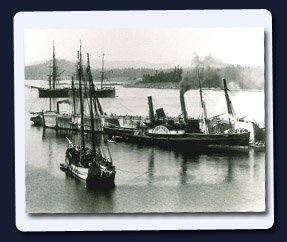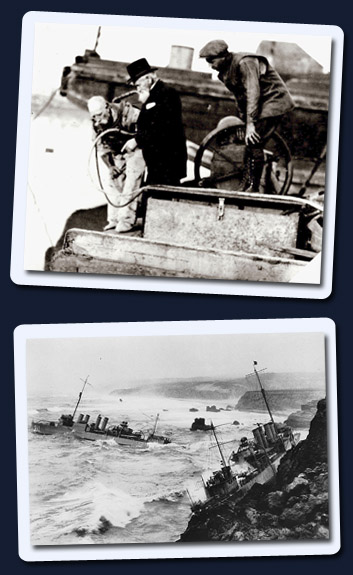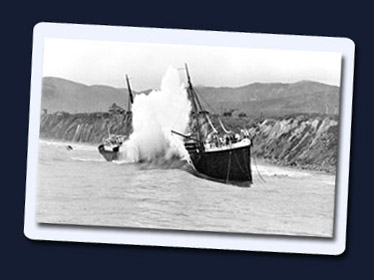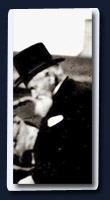Thomas A. Scott (from Chapter Two) was another notable wrecker who operated on the East Coast. His quick thinking and penchant for taking risks were shown when he was the master of the Off-Shore Wrecking Company’s tug Reliance. On January 30, 1870, the Hoboken-Manhattan ferry Union was slowly crunching her way through floating ice floes in the Hudson River, her paddle wheels near clogged with crusted ice. The ship’s decks were choked with hundreds of men, women, children, and teams of horses, congregated “near solid” against the railings and gates. An ocean tug suddenly appeared by the ship’s gunnels that early morning, veered in an attempt to miss the Union, but instead crashed into her side. Screams and shrieks pierced the cold air, and the collision’s force slashed a great V-shaped gash below the waterline while people and horses were slammed forcibly against the deck.
Weaving her way cautiously up the New Jersey coast to take on coal, the wrecking tug Reliance was within 200 yards of the collision. While the ocean tug reversed her engines to back away from the shattered ferryboat’s wheelhouse, Captain Scott maneuvered his tug toward the stricken vessel. He ran the Reliance’s bow along the ferry’s rail, gave the command to another, and dropped “like a cat” onto the ferry’s deck. Scott first ordered everyone to stand to the starboard side to right the listing craft. The increased weight on the high side gradually righted the stricken boat until she nearly regained an even keel.
Racing down into the engine room, he met the engineer halfway up the ladder and ordered him to go back. With other crewmen, the two men dragged the mattresses from the crew’s bunks, stripped away the blankets, and took whatever could be found—from racks of clothing, overalls, and cotton waste to “rags of carpet”—and crammed them into the long gash. Chilling cold water continued to rush through the rent in the ferry’s side, even as the men crammed whatever they could into the space. Finally each broken plank was covered. One area continued to flood, however, and allowed “great spurts” of green water to surge through the opening. The sea poured into the ship, deluging the floors and washing down the gratings into the hold below. As Scott surveyed the scene, he knew that everything that was loose, even oily rags, had been stuffed into the slash.
He quickly ordered the men to take their coats and vests off and shove them into the gap. Each time they forced wet clothing into the opening, the water burst out from another place like holes in the proverbial dike. Without hesitation, Captain Scott threw his own body into the gap with one arm dangling outside into the drifting ice. Although his human plug stopped the rush of water into the stricken ship, one hour passed before another tug could tow the crippled ferry back to a slip at Hoboken, New Jersey.
Scott was unconscious and barely alive due to the exposure, severe blood loss, and broken ribs that he had suffered from his actions. The water had “frozen his blood,” and the surface ice had torn hunks of flesh from his exposed arm. When he regained consciousness, Captain Scott’s first words were to ask if any of the babies had been hurt. Five weeks passed before he regained his strength and his arm healed to where he could even put on his coat. Scott then went back to work on the Reliance.
Unbeknownst to him, the Off-Shore Wrecking Company presented its bill to the ferry company for salvage, claiming that the reason for the safe return of the ship and passengers was due to the actions of its employee, Thomas Scott. The ferryboat owner refused to pay the invoice, and the wrecking company sued over its demand. The president of Off-Shore next called Scott into his office and told him, “We’re going to have some trouble getting our pay for that ferry job.” He handed him a lawyer-drawn affidavit that Scott was to sign.
Captain Scott refused and when the president asked why, he answered:
“Because I ain’t so darned mean as you be. Look at this arm. Do you think I’d got into that hell-hole if it hadn’t been for them women cryin’ and the babies a-hollerin’? And you want them to pay for it?”
Scott walked out, answered a newspaper advertisement the following day, and within one week took charge of the construction work at Race Rock Lighthouse off the west end of Fishers Island in Long Island Sound. (He would eventually return to the world of wrecking).
 * * * * *
* * * * *
Whitelaw (from Chapter Eleven) was still assuming the risks as he did nearly thirty-five years ago when he started diving, but the year in 1904 was troublesome. For example, the Respigerdo was a four-masted, iron ship used as a coal freighter that had grounded on Point Montara off the California coast. She was stuck fast, but apparently could be saved, provided the salvage crew could work faster than the destructive tides and winds.
With the sea being calm, the salvagers felt no great hurry or excitement. In fact, when the noon hour came, all of the workers except one left to eat lunch on the nearby anchored steam-wrecker. The man who remained wanted to study the wreck more and be sure the plans to refloat her were workable.
Captain Whitelaw sat down on a hatch midway on the wreck and began to work over the plans in his mind. The vessel creaked a little and then groaned, but there seemed to be nothing unusual about that. He suddenly heard a “terrific ripping sound and great splintering,” as if a volcano was heaving underneath the wreck. The Respigerdo—a 220-foot long ship—then broke in half.
Whitelaw was by himself, and it was as if a jagged, invisible knife had sliced across the Respigerdo. The seaward half cracked down so fast under T.P.H.’s feet that he almost fell down. As Whitelaw started to step across the crack, the rupture suddenly widened from a few inches to five feet. He backed up, ran several feet, and jumped as hard as he could—to land successfully on the grounded half.
| TALES OF THE SEVEN SEAS | TAKING THE SEA | SENTINEL OF THE SEAS | TREASURE SHIP | THE RAGING SEA |
|


 Whitelaw was seen by reporters as “the man who has braved the dangers in handling the big wrecks of this long period and is nothing short of a hero.” They wrote, “The tales of his prowess are passed on from lip to lip.” Other accounts maintained that “among the most superstitious of seafaring men, Captain Whitelaw is often accredited with having super powers.
Whitelaw was seen by reporters as “the man who has braved the dangers in handling the big wrecks of this long period and is nothing short of a hero.” They wrote, “The tales of his prowess are passed on from lip to lip.” Other accounts maintained that “among the most superstitious of seafaring men, Captain Whitelaw is often accredited with having super powers.